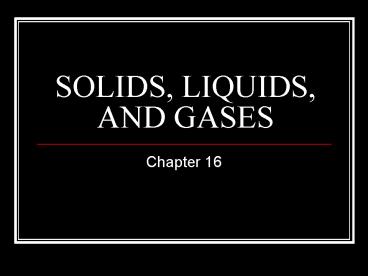SOLIDS, LIQUIDS, AND GASES - PowerPoint PPT Presentation
1 / 15
Title:
SOLIDS, LIQUIDS, AND GASES
Description:
States of matter solid, liquid, gas. Kinetic theory ... 4. An object will bloat if its density is less than the density of the fluid it is placed in ... – PowerPoint PPT presentation
Number of Views:4599
Avg rating:3.0/5.0
Title: SOLIDS, LIQUIDS, AND GASES
1
SOLIDS, LIQUIDS, AND GASES
- Chapter 16
2
Section 1 Kinetic Theory
- States of matter solid, liquid, gas
- Kinetic theory explains how particles in matter
behave - All matter is composed of small particles
- Particles are in constant, random motion
- Particles collide with each other and walls of
their containers
3
- Thermal energy total energy of a materials
particles causes particles to vibrate in place - Average kinetic energy temperature of the
substance, or how fast the particles are moving
the lower the temperature, the slower the
particle motion - Solid state particles are closely packed
together in a specific type of geometric
arrangement
4
- Liquid state a solid begins to liquefy at the
melting point as the particles gain enough energy
to overcome their ordered arrangement - Energy required to reach the melting point is
called the heat of fusion - Liquid particles have more space between them
allowing them to flow and take the shape of their
container
5
- Gaseous state a liquids particles have enough
energy to escape the attractive forces of the
other particles in the liquid - Heat of vaporization is the energy required for a
liquid to change to a gas - At the boiling point, the pressure of the
liquids vapor is equal to the pressure of the
atmosphere, and that liquid becomes a gas - Gas particles spread evenly throughout their
container in the process of diffusion
6
- Heating curve of a liquid as a solid melts and
a liquid vaporizes, the temperature remains
constant - Plasma state of matter consisting of
high-temperature gas with balanced positively and
negatively charged particles
7
- Thermal expansion increase in the size of a
substance when the temperature increases - The size of a substance will then decrease when
the temperature decreases - Expansion and contraction occur in most solids,
liquids, and gases - Water is an exception because it expands as it
becomes a solid
8
- Some substances do not react as expected when
changing states - Amorphous solids lack the tightly ordered
structure found in crystals - Glass, plastic
- Liquid crystals do not lose their ordered
arrangement completely upon melting used in
liquid crystal displays
9
Section 2 Properties of Fluids
- Buoyancy ability of a fluid (liquid or gas) to
exert an upward force on an object immersed in it - An object in a fluid will float if its weight is
less than the buoyant force acting on it from the
fluid - An object in a fluid will sink it its weight is
more than the buoyant force acting on it from the
fluid
10
- 3. Archimedes principle buoyant force on an
object is equal to the weight of the fluid
displaced by the object - 4. An object will bloat if its density is less
than the density of the fluid it is placed in
11
- Pascals principle pressure applied to a fluid
is transmitted throughout the fluid - Pressure is force exerted per unit area
- Hydraulic machines use this principle to lift
heavy loads - Bernoullis principle as the velocity of a
fluid increases, the pressure exerted by the
fluid decreases airplanes use this principle to
fly
12
- Viscosity a liquids resistance to flow
- Molecular structure determines a fluids
viscosity - Increased temperature will lower viscosity
13
Section 3 Behavior of Gases
- Pressure is measured in units called pascals (Pa)
- Collisions of particles in air result in
atmospheric pressure - Moving particles colliding with the inside walls
of a container result in gas pressure
14
- Boyles law relates pressure and volume
- Volume decreases as pressure increases
- Pressure decreases as volume increases
- Pressure multiplied by volume is always equal to
a constant if the temperature is constant
15
- Charless law relates volume and temperature
- At a constant pressure, volume increases as
temperature increases - At a constant pressure volume decreases as
temperature decreases - Gay-Lussacs law relates pressure and
temperature at a constant volume, as temperature
increases, pressure increases































